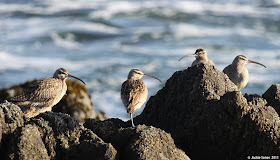In the picture below there are four different invertebrates (in four different phyla) that brood their young. This might be tricky, but can you find all four species?
(1) Proliferating Anemone (Epiactis prolifera). Phylum Cnidaria. Orange with white stripes (although color in this species is highly variable). At least 8 young are being brooded by this adult. Fertilized embryos are moved from the mouth across the oral disc and then down to a depression at the base of the column. The mother broods the juveniles for about 3 months and then they depart to live independently.
(2) Six-armed Seastar (Leptasterias sp.). Phylum Echinodermata. Small pink seastar. This individual was only about 1 cm across, but maximum size for this species is about 5 cm. Females brood clusters of eggs under their bodies for about 6 weeks and then the tiny juvenile seastars crawl away from the mother. (See more photos below.)
(3) Spirorbid tube worm. Phylum Annelida. Small white coiled tubes (see post on 6 February 2012). Fertilized embryos are retained and brooded either along the abdomen, in a brood chamber, or within the operculum. Planktonic larvae are released into the water, but settle after a very short time.
(4) Tube snail (Petaloconchus montereyensis). Phylum Mollusca. Purple-orange tube on the upper left side of the photo. This is a vermetid gastropod that builds calcareous worm-like tubes and lives cemented to the rock. Eggs are brooded within capsules inside the tube, juveniles complete their development within the capsules and then emerge from the tube as small snails and attach to a nearby rock.
Six-armed Seastar with eggs. Their main brooding season is winter and spring.
Six-armed Seastar adult with many tiny juveniles in the lower right corner. How many can you find?
Different eyes might find different individuals, but I found at least 15 juveniles.
The first photo was taken at The Great Tidepool in Pacific Grove, but all four species are also found on Bodega Head. The second and third photos were taken on Bodega Head.


















































